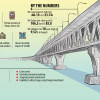Betel leaf cultivation creeping up as exports expand

Betel leaf grown in Kushtia is not only popular across Bangladesh, but also beyond the country's borders with increasing exports in the last several years encouraging more farmers to cultivate the crop.
As such, betel leaf was cultivated on 2,230 hectares of land in fiscal 2021-22, up by some 4 per cent compared to 2,140 hectares the year before, according to sources at the Department of Agricultural Extension (DAE) in Kushtia.
Although the crop is grown throughout the district, three upazilas -- Kushtia sadar, Mirpur and Bheramara -- are the top producers.
Abdullah Al Mamun, agriculture officer of Mirpur upazila, said his region exports the most betel leaf with 20 tonnes of the crop having been shipped to countries in the Middle East as well as England in the previous fiscal.
Meanwhile, Kushtia sadar upazila and Bheramara upazila exported 22 tonnes and 27 tonnes respectively but unlike Mirpur, the leaves were collected from various other regions as well.
"Kushtia Paan has great potential in earning foreign currency. So, it can be considered whether any big project can be undertaken for betel leaf growers in the district," said Ramesh Chandra Ghosh, director of the Sustainable Agricultural Development Expansion Project in Jashore
On average, Tk 35 crore worth of betel leaf is exported from the three upazilas each year.
Kushtia has always been a betel leaf growing district but farmers had once turned away from its cultivation in the face of constant losses.
However, earnings from betel leaf have risen in the past three years and as a result, many farmers are once again inclined to grow the crop.
The local farmers now use organic pesticides, which has enabled healthier and safer cultivation while also boosting yields.

Several local varieties of the plant are being cultivated alongside high yielding and disease resistant species, such as Bari Paan-1, 2 and 3.
Among them, Bangla Paan and Mitha Paan the most popular among farmers for their resistance to rot, leaf burn and other diseases.
Local agriculture officials say they have trained farmers in the modern methods of betel leaf cultivation and conservation in addition to the correct way of applying pesticides.
As a result, betel leaf growers in the district are earning up to Tk 1.5 lakh per bigha.
Even just a few years ago, many farmers were engaged in tobacco cultivation in hopes of better profits but now, they are turning back to betel leaf for a quick path to self-sufficiency.
Among them is Hashem Ali Khan, a youth of Hazrahati village in Mirpur upazila, who achieved solvency through his two-and-a-half bigha betel leaf plantation.
Hashem expects to earn more than Tk 3 lakh from the crop this year.
Shahidul Islam, a farmer from the Kuchiamora area of Bheramara upazila, said he has been cultivating betel leaf instead of tobacco for the past two years. Islam grew Bangla Paan on one bigha of land last year, when he earned around Tk 1.5 lakh from his harvest.
This year, Islam is cultivating Bangla Paan on three bighas of land as this variety of betel leaf has high demand in different parts of the country.
Abdur Rahman, another grower from Bheramara upazila, said he has been sending betel leaf to Dhaka, Chattogram and Sylhet for a long time now.
"In the past, profits were low as only expensive and inaccessible modes of transportation were available," he added.
But after the launch of Padma Bridge, Rahman has been able to bring his betel leaf to various markets by himself, saving both time and money.
As such, Rahman's profits have almost doubled.
Officials of the Kushtia DAE said betel leaf growers in the region use non-toxic organic pesticides, including combinations of mulberry, lime and water, that produce good results while also keeping costs comparatively low.
Saidul Islam, a farmer from Brittipara village in Kushtia sadar upazila, said growers in the region would previously use conventional pesticides but have since switched to organic cultivation after getting good results.
Ramesh Chandra Ghosh, director of the Sustainable Agricultural Development Expansion Project in Jashore, said farmers in Kushtia are getting more profit than ever by cultivating betel leaf.
"They are earning Tk 1 to Tk 1.5 lakh per bigha by cultivating betel leaf in a modern way," he added.
Ghosh went on to say that even a few years ago, farmers were leaning towards tobacco cultivation considering its higher profits.
"Kushtia Paan has great potential in earning foreign currency. So, it can be considered whether any big project can be undertaken for betel leaf growers in the district," he said.

 For all latest news, follow The Daily Star's Google News channel.
For all latest news, follow The Daily Star's Google News channel. 








Comments